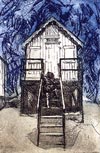Etching

A flat metal plate is first coated with an acid resistant ground, which consists of bees wax, bitumen and resin. The plate is gently heated and the wax ground is melted on to the surface and spread evenly in a thin layer using a hard wearing roller or dabber.
The plate is allowed to cool, the wax hardens and is then ready for the design to be scratched through the hardened coating, exposing the metal below.
Alternatively or in combination with, a bitumen based varnish (or stop out varnish) can be used to paint out the areas of the plate you do not wish the acid to affect.
The whole plate is then immersed into the acid. This burns or etches only the exposed areas of the metal plate where the design has been drawn.
The longer the plate remains in the acid, the deeper the lines are etched. The depth and density of the etched lines controls the tones of the print.